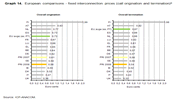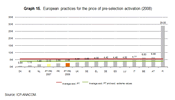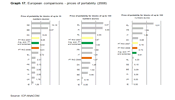In 2008 the decision was approved on the conditions of the RIO, to apply in 2008 (decision of 16 May 2008) and the DD on the changes to be made to the RIO in 2009 (DD of 4 December 2008).
Since the DD refers to the conditions to be applied in 2009, this Report only refers to the conditions applying to 2008.
a) Call origination and termination prices
With the approval of the determination on the RIO in 2008, new prices were set for the origination and termination of calls with effect from 12 March 2008, determining reductions over prices previously in force, as detailed in the following table.
|
Level |
Call activation |
Price per minute |
||||
|
Peak |
Off-peak |
|||||
|
Local |
0.50 → 0.49 |
-2% |
0.39 → 0.38 |
-3% |
0.20 → 0.19 |
-5% |
|
Simple Transit |
0.57 → 0.52 |
-9% |
0.63 → 0.58 |
-8% |
0.32 → 0.29 |
-9% |
|
Double Transit |
0.66 → 0.62 |
-6% |
1.05 → 0.99 |
-6% |
0.56 → 0.53 |
-5% |
Billing shall be per-second from the first second. Peak hours will be applicable between 9am and 7pm on working days, and Off-peak hours in remaining periods.
Source: ICP-ANACOM.
The reductions determined in accordance with the principle of cost orientation of prices result, compared to prices of RIO 2007, in approximate average nominal reductions (based on a call duration of three minutes, and considering the traffic profile envisaged by PTC for 2008) of 4.9 percent for termination and of 4.8 percent for origination. In real terms these amounted to average reductions of 2.8 percent and 2.7 percent respectively, taking into account the rate of inflation forecast in the 2008 State Budget.
The maximum prices determined make it possible to preserve a balance between the need to provide an incentive for own infrastructure development and the need to promote effective competition, also enabling an approach to current EU practice, as can be seen in the graphs below.
Graph 14. European comparisons - fixed interconnection prices (call origination and termination) 1
Accordingly, in terms of European comparisons, the prices established for interconnection represent an improvement in Portugal's ranking compared to the EU average (EU15), both in terms of origination and termination, and compared to the various countries of the EU15.
This reduction in prices, determined in accordance with the principle of cost orientation of prices, brought improvements to competitive conditions in the sector, and it can be seen that prices for interconnection in Portugal (for both call origination and termination) for all levels of interconnection and pricing periods, are significantly below the EU15 average (excluding Portugal) in a range that is between -26 percent and -4.6 percent.
b) Capacity-based interconnection (flat interconnection tariff)
By determination of 16 May 2008, ICP-ANACOM approved the conditions to apply in the RIO 2008, with price reductions determined in terms of capacity-based interconnection, with the following changes in prices:
|
Level |
RIO 2007 (from 26.03.2007) |
Maximum prices |
Deviations from maximum prices |
|
Local |
€ 1,162.09 |
€ 1,123.69 |
-3.30% |
|
Simple Transit |
€ 1,858.19 |
€ 1,690.35 |
- 9.03% |
|
Double Transit |
€ 2,593.98 |
€ 2,130.26 |
- 17.88% |
Source: Calculations of ICP-ANACOM.
In the response to the DD of 19 March 2008 on conditions to apply in RIO 2008, PTC sent a proposal for a significant increase in prices associated with capacity-based interconnection (of around 78 percent), considering the theoretical model unsuited to reality.
As such, in the cited determination on RIO 2008, ICP-ANACOM stated, with respect to the provision of capacity-based interconnection, that the data provided by PTC should be presented to a greater level of detail, along with other information considered relevant which should be made available. Accordingly, it was not considered appropriate, at that time, to drop the established theoretical model or to change it significantly.
It should also be noted that this Authority, considered that significant increases in the prices associated with capacity-based interconnection, as proposed by PTC, cannot be made without conducting a more thorough analysis of the issue. Accordingly, and with a view to regular monitoring being conducted by the Authority on the levels of use of this mode of interconnection, ICP-ANACOM requested more detailed information on this issue, especially regarding the traffic routed using this mode of interconnection.
Subsequent to this decision, ICP-ANACOM requested and received clarification and additional information from PTC, whereas in November 2008 the company submitted a new proposal containing a reassessment of the parameters of the theoretical model.
Under the conditions described, by determination of 23 December 2008, ICP-ANACOM approved a DD considered appropriate to maintain the application of the theoretical model with the alteration of some parameters and proposed a gradual introduction, setting a specific "glide path".
The same DD also set out, with effect from 1 January 2009, an increased penalty to be applied in situations of traffic transfer using circuits associated with time-based interconnection at the same Interconnection Point (GIP).
c) Prices of the service of billing, collection and risk of non-recovery
With the cited determination of 16 May 2008, it was decided to enact reductions with regard to Pac’s maximum prices of billing, collection and risk of non-recovery, as established in RIO 2007, taking into account the costs associated with this service.
Accordingly, ICP-ANACOM established maximum prices for billing, collection and risk of non-recovery, to take effect from 12 March 2008:
(i) 2.90 euro cents per call for services where the cost to the caller does not exceed Local PTC (as defined in Pac’s tariff for residential customers);
(ii) 3.17 euro cents per call for other special non-free services;
representing approximate reductions of 5.8 percent and 7.8 percent for the services referred to in (i) and (ii), respectively.
d) Price of pre-selection activation
ICP-ANACOM deemed it appropriate to set a new maximum price for the activation of pre-selection (to take effect from 12 March 2008) at 2.66 euros. This price represents an increase of 25 percent but maintains Portugal in the group of the top five positions relative to the EU15, as shown in the following graph.
Graph 15. European practices for the price of pre-selection activation (2008)
e) Prices for the activation of number portability
New price caps were set for the activation of porting by number, representing sharp reductions, as can be seen in the following table.
|
|
Maximum price |
Maximum price |
Percentage |
|
Individual porting |
€ 5.39 |
€4.01 |
-25.6% |
|
Blocks of 1 to 9 numbers |
€ 4.25 |
€ 4.01 |
-5.6% |
|
Blocks of 10 to 99 numbers |
€ 1.67 |
€ 1.47 |
-11.8% |
|
Blocks of numbers u2265100 |
€ 0.79 |
€ 0.73 |
-7.6% |
Source: ICP-ANACOM
With respect to the price of porting individual numbers a decrease of about 26 percent has been seen which places the value in Portugal among the lowest in the EU15 and about 53 percent below the EU15 average (excluding Portugal), as illustrated in following graph.
Graph 16. European practices on the cost of number portability per individual number (2008)
With respect to porting blocks of numbers, Portugal 's ranking has remained in line with the EU average, as illustrated in the chart below.
Graph 17. European comparisons - prices of portability (2008)
1 The figures shown above for each country were obtained by applying the weightings of estimated interconnection traffic to the interconnection tariffs applying in each Member States (average price per minute for a three minute call) in order to obtain, for both call origination and call termination, an indicator that can be used to assess the various elements of interconnection in an integrated manner.








